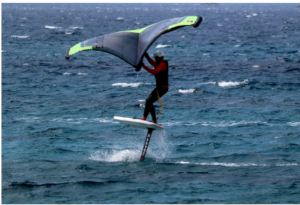Getting upwind efficiently and comfortably is essential to wing foiling. The goal is to turn the battle between you, your wing and the board into a beautifully orchestrated symphony.
 The first step is to prepare the equipment. It may involve buying a new wing, although depending on the size of your existing wing, it might work just fine for you. For quality wing foiling, check this out.
The first step is to prepare the equipment. It may involve buying a new wing, although depending on the size of your existing wing, it might work just fine for you. For quality wing foiling, check this out.
It’s Easy to Learn
Unlike windsurfing or kitesurfing, wing foiling requires less equipment and water than those sports, plus it’s more portable. It can also be done in conditions that would otherwise be unusable because the foil generates lift without a breaking wave or surfboard.
The sport is easy to learn if you have experience with a board sport, particularly surfing or windsurfing. The control system for the wing is similar to that of a mast-powered sail, so learning to use the controls (mashing back to go upwind, front arm straight to maximise power and pumping to get bursts of speed) should be familiar.
The other key to learning quickly is selecting the right gear. Nothing hinders the learning process more than inappropriate equipment. For example, selecting a foil that is too small for your body weight will make it difficult to stay upwind and hard to manage when you do catch wind. Choosing the right size will also enable you to ride the wing in a broader range of wind and sea conditions.
It’s Fun
The feeling of levitating across the water, harnessing wind power, is incredibly satisfying. There is a real sense of achievement every time you manage to ride the wing and balance on your board. It’s also a great sport to do with friends. For quality wing foiling, check this out.
It’s easiest to learn wing foiling on a lake or sheltered ocean bay free of waves and other water users. The ideal spot for a beginner is a large half-moon bay with a shoreline that’s easy to walk back to in case of falling off your foil.
The best wing foil boards are short, wide and very thick, cramming plenty of foam into a small space to maximise stability. They are also neutrally or negatively buoyant to make it easier for newcomers to get onto the foil. It’s essential to select a set-up that matches your goals, weight and local wind conditions. Windier winds will require a larger wing than lighter wind conditions.
It’s a Sport
Wing foiling is a full-on sport that has captured the imaginations of water sports enthusiasts across all disciplines. It has even pushed the limits of windsurfing and kitesurfing and is poised to become a future Olympic sport.
Once you have progressed enough to be able to stay upwind, you can then consider a smaller board. Your size depends on your goals, weight and local wind conditions. You will also need to decide if you want to ride with or without foot straps on the board. It is a personal preference, but having the straps can help you learn and perform advanced manoeuvres more readily.
It’s a Community
Wing foiling is an easy-to-learn new water sport that offers a unique and irresistible sensation. It’s like surfing or windsurfing but without any tangled lines and equipment that can cause injury. For quality wing foiling, check this out.
Wing foiling is considered a low-impact water sport that all ages and abilities can enjoy. It’s an excellent option for experienced windsurfers looking for a new challenge or paddleboarders who want to experience the thrill of gliding on a wing.
Wing foiling also allows people to explore spots that typically lack wind for traditional kiteboarding or windsurfing. Small lakes, choppy waters, and even windy city spots can all be fun and exciting wing-foiling locations.
How to Learn Wing Foiling
As an enjoyable and easy-to-learn sport, wing foiling is the latest wave of the new craze. It’s a great way to open up spots that may have been considered a no-go for wind sports.